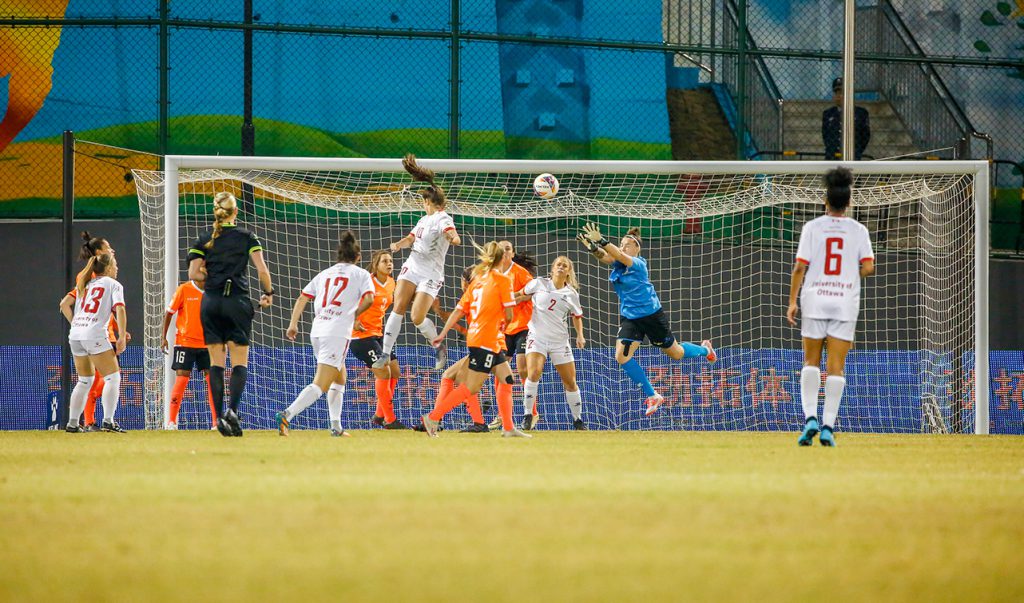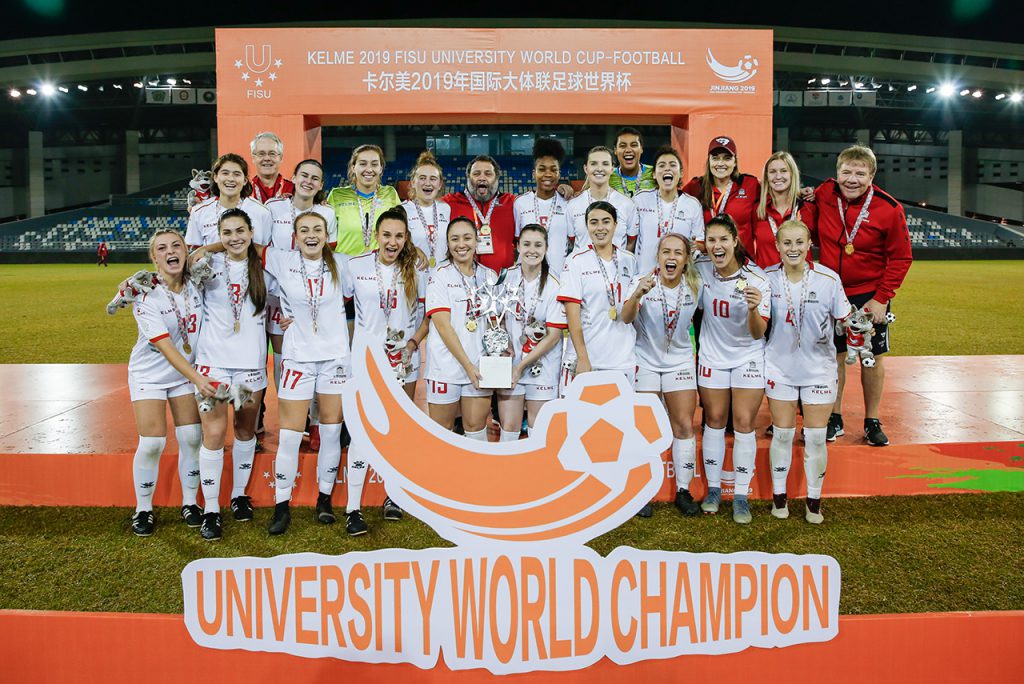STUART BARBOUR //
How often have you been to matches and heard players and coaches hollering “play our game,” or “play our style”? You may have just arrived at the pitch and have no idea of the score but you can usually figure out who is winning just by listening to the tone, frequency and volume of these shouts from one team or the other. But what does “play our game” really mean? Do the players understand when the coach instructs players to “play our game”?
The intent of this article is to provide insight into the start of a process that the University of Ottawa (uOttawa) Gee-Gees and the Cairine Wilson S.S. Wildcats used to guide their women’s soccer teams to success on the pitch. It was the start of the framework to get the teams to “play our game” and to understand what that meant and to guide the players’ decision-making during the match.

Team Background
The University of Ottawa Gee-Gees play in the Ontario University Athletics (OUA) league and the two top teams from the province move forward to compete in the U-Sport Canadian National Championships against universities from all across Canada.
In October of 2018 the Gee-Gees captured the OUA title and went on to win the Canadian National Championship in November. What we did not know at the time was U-Sport had accepted a wildcard position for a Canadian school to compete at the inaugural FISU University World Cup of Football in Jinjiang, China, in November of 2019. As Canadian Champions, we were offered and gladly accepted the position. More about our results in China later.
In late 2013 the coaching staff were looking for ways to “get players on the same page” to create a common set of governing principles that would lay the foundation of how we wanted to play as a group. We wanted to create an environment where players could assess their decision-making as the game was being played to determine if their actions were the most effective in that moment.
The inspiration for the Golden Rules came from reading a reference to The Philadelphia Flyer’s Bible that was created by legendary hockey coach Fred Shero. Shero was the coach of the Flyers from 1971 to 1978 and guided the team to two Stanley Cups.
He created 11 rules that make the difference between winning and losing. Legend has it he would sometimes burst into the locker room at the end of a game and demand players write out all the rules they broke five times. He did not have to even mention the players’ names as they knew who they were and willingly obliged. Shero was also known for his motivational messages written on the locker room blackboard. His most famous, going into game six against the Bruins with an opportunity to clinch the Cup, was “Win today, and we walk together forever.” The Flyers went on to become the first expansion team to win the Stanley Cup.
The process to create a set of Golden Rules for the Gee-Gees started with a simple internet search to uncover the Flyer’s Bible. The coaching staff all got copies of the Flyer’s Bible and we started to debate the relevance of the hockey rules as they applied to soccer. As many of our road games involve long bus rides, the conversations usually took place there and we went through a few versions to come up with what was considered the Golden Rules for the Gee-Gees. The rules are geared toward that particular era of players based on their technical skills and tactical awareness at that point in time. The Golden Rules are very organic, they continue to change and evolve with the team and era of players being coached; they are customized to the game-winning style we are promoting at the time.
The Golden Rules were presented to the team as a PowerPoint with a guided discussion on a road trip and then reviewed again just prior to the playoffs. The coaching staff made a concerted effort to refer to the rules during practices, half-time talks, post-game talks and video analysis sessions. It was felt this was the best way to reinforce the principles of play we were looking for to create a game-winning style and formula.
What is presented next are the key points associated with the slides that were presented to the team.
The Game of Soccer
One of the first tasks was to get the players to develop a deeper understanding of the game they play. The following statistics were presented to the team using the Socratic method of first posing questions to the team: “How far do you think the average player runs in a game?” “How much distance do you cover with the ball?” “How much time do you spend on the ball?” The research-based answers below were then revealed to the team to guide further discussion.
» The average player covers 11 kms (6.8 miles) per match
» They run with the ball for 1.5% of that distance, about 191 meters (209 yards)
» They have the ball for 53.4 seconds in the match
» The average possession per player:
› 2 touches and lasts 1.1 seconds
Players were asked to discuss in small groups what the four previous key facts meant in relation to the question posed: What are players doing in 98.5% of the game?
The player = the decision-maker
The other 98.5% of the game is spent making decisions about where to move, when to move, where to pass, when to pass, where to tackle, when to tackle, to drop or to press, to shoot or to cross, to catch or to punch, to throw or to punt.
Legendary Liverpool F.C. manager Bob Paisley often explained to his players “you don’t pass with your feet; you pass with your brain” and “it’s not about the long ball or the short ball; it’s about the right ball.” These quotes clearly indicate the importance of decision-making in a sport with frequent and fluid changes of possession—the modern player has to be adept at making correct decisions with lightning speed and execution.
As coaches we know it is very difficult to micro-manage every decision that 11 players make on the pitch. Some coaches will use this as a coaching style. They usually end up more exhausted than their players while taking the joy of the game away from some and leaving others questioning everything they do on the pitch, or worse, they have players waiting to be told what to do during the game.
The goal as coaches should be to teach and empower our players to make decisions in the game with confidence and independence. The challenge in a team sport is to create independence in the framework of the interdependence of teamwork. When a coach shares the principles that they feel guide a team to play successful soccer they are creating the “common page” that all players can draw from during the run of play. We want players and, therefore, teams to sense changing moments in the game, both in and out of possession, reacting instinctively and intelligently.
The Golden Rules are organized around the three key moments in soccer: in defense, in transition and in attack with the one key overriding principle below:
Always Play the Score and the Time of the Game
All decisions in the game are made around the score of the game and the time on the clock. Players need to understand these constraints in order to make the right tactical decision at the correct time. How often have you seen a team leading by a goal send players forward for an attacking free kick or corner kick only to give up a goal on the counter-attack late in a game?
If we are up one-nil with 10 minutes to play, do you cross or take the ball to the corner flag? If we are down a goal with five minutes to play and have a corner kick, do we commit two center-backs to the attack?
The slides were created using quality photos of Gee-Gee players engaged in the three key moments of the game. For the “in defense” section, images of players executing great slide tackles or winning an aerial duel were used. The “in transition” phase used images of players competing for 50-50 balls or shaping their body to pass after winning a tackle. The “in attack” section used images of players scoring goals, shooting or celebrating a goal!
In Defense
- Strikers are our first line of defense = win the ball back early or channel opposition
- Gee-Gees play no-bounce soccer (throw-ins included)
- Never tackle (foul) a player moving backwards away from our net and no unnecessary fouls in our half
- Never pass square in the defensive 1/3 or midfield 1/3 unless 100% sure of possession
- In the box, track your man; do not abdicate responsibility until 100% sure the next player will pick up
- Back to net – see your man – see the ball
- Clearances are to be = high – far and wide
In Transition
- Move fastest when the ball is in flight
- Win the ball back in 4 seconds or reset our shape
- Never allow our team to be out-numbered in the defensive zone
- Get 8 players behind the ball as fast as possible
- Mid on mid “box to box” and we will never be out-numbered
- Attack quickly / direct when opposition is out of balance or stretched
- Play the ball forward within 3 touches = break lines, eliminate opposing players, play positive
- Play the ball behind the opposition’s defensive line as early as possible
- If no direct attack = establish possession after transition with a 2- or 3-pass sequence that switches the field of play
In Attack
- Never a straight ball and straight run
- Straight balls require diagonal runs
- Diagonal balls require straight runs
- Never pass blindly
- See a player / establish eye contact
- Play to a dangerous place
- Play to call from a teammate
- Never go offside in an attacking move; it is like playing defense for the other team
- Shoot at the earliest opportunity
- “You miss 100% of all shots you do not take”
- The second attacker must always drive straight to net
- Focus on ball / looking for rebound angle
- “Expect the unexpected!”
- No ball goes through the attacking penalty area unchallenged (nothing out the back of the box)
- When there is no attacking option = turn back = reset and keep possession
The KELME 2019 FISU World Cup of University Football
The Gee-Gees traveled to China in November 2019 to compete in the inaugural World Cup of University Football. The door-to-door journey was over 7,000 miles and travel time was a mere 36 hours and 12 time zone changes.
Each participating university was representing their soccer confederation. The men’s tournament consisted of 16 teams arranged into four groups while the women’s tournament hosted 8 teams split into two pools. The tournament was held over 12 days with elaborate opening and closing ceremonies. Teams had a match every other day and trained on their off days. The FISU event staff also organized cultural and educational outings for the student-athletes to experience and appreciate this small corner of China on their non-match days.

In the opening group game, uOttawa played Donghua University from China and won 2-0. This was followed by a 3-0 victory over Russia’s Siberian Federal University. The final pool game was against the College of Asian Scholars from Thailand to determine top spot in the group. The Thai team was a very slick passing team with excellent team shape throughout the match. The Gee-Gees won the tight, highly skilled match 4-2 and finished first in their group.
In the semi-final, the Gee-Gees crossed over to compete against Beijing Normal University. This match was played at Jinjiang’s modern 8,000-seat Football Park Stadium and the team was greeted by a large crowd with a very loud pro-Beijing section of supporters with drums, flags and chants. The teams played to a nil-nil tie and the match was decided by penalty kicks. The Gees-Gees converted all five of their kicks and keeper Margot Shore pulled off a stunning full-stretch save to secure victory for the proud Canadians.
The final was against the powerful and much-favored Paulista University from Brazil, the only university to have both their men’s and women’s teams qualify for the tournament. The Gee-Gees came out flying at the Football Park Stadium. Mikayla Morton scored a brilliant header from a corner kick in under two minutes. The Gee-Gees dug deep and worked their socks off for the next 88 minutes to become Champions of the inaugural KELME 2019 FISU University World Cup. It was a truly amazing group of players and staff to work with at the tournament of a lifetime. “We now walk together forever.”
The Cairine Wilson S.S. Wildcats
My role with the Gee-Gees is that of assistant coach to Steve Johnson in the fall and over the winter seasons. In the spring season I switch over to become head coach of Cairine Wilson S.S. Wildcats in Ottawa. I taught social science there for 32 years and guided the varsity girls’ team to 10 National Capital City Championships and 11 appearances at the Provincial Championships where the team won two provincial medals. The Gee-Gees Golden Rules were adapted to fit the characteristics of a very solid high school team.
A team’s legacy and tradition are important. And it is key to get the team to understand they are part of something bigger than just their season and their career. As a varsity team, many of the players would be on the team for four years and see their roles and responsibilities expand over their high school years.
The slide show for the Wildcats included a history of the team and we used select action photos of graduating seniors that the juniors knew and looked up to. We even included photos of older sisters and cousins who had graduated much earlier to help create that connection. Another feature was photos from tournaments and tours the team had taken to Texas, Victoria and Vancouver in British Columbia, and England. Other key photos included action shots from the previous season using players that were still part of the squad. The lecture/slide show was conducted at a team breakfast just after the new team was selected and was designed as a starting point for the new season.
The last images were often of graduated seniors holding medals and posing with trophies with statements like “it is now up to you,” “how will your team be remembered?” or “what will your legacy be?” You could often hear a pin drop at the end of the presentation and there was on the odd occasion a moist eye.
Your challenge …
Now more than ever, establishing a series of Golden Rules or principles of play to follow is of paramount importance. As a result of the COVID pandemic, varsity soccer programs have lost an entire season and playoffs, their off seasons and some players have even lost their summer soccer for two years in a row. Suddenly your first-year rookie players are third-year players expected to be leaders without the growth and development that would have occurred in their second year. Depending on graduations, coaches may find themselves with a squad where over half their players have no varsity experience when the 2021 seasons kick off. Now is the right time to develop your team’s Golden Rules and connect your first- and second-year players to the legacy of past squads. I already know some of the Gee-Gees’ images from China I will incorporate into this season’s Golden Rules slide show.
Reprinted with permission from United Soccer Coaches. Originally appeared in the November/December 2021 issue of Soccer Journal. https://unitedsoccercoaches.org/soccer-journal-issues/
Visit the uOttawa Gee-Gees: https://teams.geegees.ca/sports/wsoc/index

The MOTI Sports Team are sport training fanatics and lovers of all sports! A select group of highly skilled and talented individuals across multiple disciplines.

